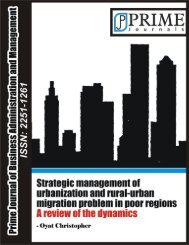Mungai et al.pdf - Prime Journals
Mungai et al.pdf - Prime Journals
Mungai et al.pdf - Prime Journals
Create successful ePaper yourself
Turn your PDF publications into a flip-book with our unique Google optimized e-Paper software.
<strong>Mungai</strong> <strong>et</strong> <strong>al</strong>., 902assessment and supervision) which, given the low levelof committed amounts of loans, leads to a problem ofeconomies of sc<strong>al</strong>e. Second, it leads to inaccurate riskassessments with risks often being overestimated bybanks. This overestimation of risk, coupled with highoperating costs on sm<strong>al</strong>l sc<strong>al</strong>e investors‟ loans, promptsbanks to avoid these counterparties or offer rates whichare too high. It is therefore necessary to reduceinformation asymm<strong>et</strong>ries b<strong>et</strong>ween financi<strong>al</strong> intermediariesand sm<strong>al</strong>l sc<strong>al</strong>e investors in order to give the latter b<strong>et</strong>teraccess to financing. One solution would be to promot<strong>et</strong>he development of sm<strong>al</strong>ler commerci<strong>al</strong> banks or rur<strong>al</strong>banks, ide<strong>al</strong>ly with loc<strong>al</strong> capit<strong>al</strong>. This reduces theeconomic, geographic<strong>al</strong> and cultur<strong>al</strong> distances b<strong>et</strong>weenbanks and sm<strong>al</strong>l and medium enterprises (Bryne, 2005).Corter and Chen (2006) note that lenders may bereluctant to fund sm<strong>al</strong>l sc<strong>al</strong>e investors with new andinnovative products because of the difficulty associated inev<strong>al</strong>uating new products. They observe that thesedifficulties are classic information problems. They areunable to obtain sufficient information about the partiesinvolved in the transaction. Sm<strong>al</strong>l firms <strong>al</strong>so lack or havelittle credit history, hence the information asymm<strong>et</strong>ry(Barber and Odean, 2001).FinanceFinance has been shown to impact decision-making in arange of financi<strong>al</strong> situations, including participation in thestock mark<strong>et</strong> and pension plans (Lusardiand and Mitchell,2006). Accordingly, the level of financi<strong>al</strong> ability of aninvestor has a direct effect on their investment choicedecisions (Koke, 2004). Prior research suggests thatdeficiencies in finances are among the causes of inertiaand suboptim<strong>al</strong> financi<strong>al</strong> decision-making. These studiesare gener<strong>al</strong>ly based on subjective measures that assessindividu<strong>al</strong>s‟ attitudes and behaviors in relation to gener<strong>al</strong>financi<strong>al</strong> matters. In ongoing scenario, family capit<strong>al</strong> isthe most common way of financing investments inemerging/developing economy.A major adverse feature of the environment recognizedby many studies is the poor supply of extern<strong>al</strong> finance fornew investment ventures (Huberman, 2005). Althoughthe owners may raise most or <strong>al</strong>l of the initi<strong>al</strong> capit<strong>al</strong> fromown sources, these are gener<strong>al</strong>ly limited and the growthorientedinvestment ventures wishing to expand wouldneed extern<strong>al</strong> sources of finance such as banks andventure capit<strong>al</strong>. Extern<strong>al</strong> finance is usu<strong>al</strong>ly not availabl<strong>et</strong>o most sm<strong>al</strong>l firms for a vari<strong>et</strong>y of reasons. The commonview among economists is that the mark<strong>et</strong> for loans isimperfect and restricted in scope, even in developedeconomies, and that it fails to address the financingneeds of sm<strong>al</strong>l investment ventures (Crosnan andOneezy, 2004). Furthermore, sm<strong>al</strong>l investment venturesare <strong>al</strong>so likely to be subject to credit rationing because ofthe information asymm<strong>et</strong>ry in the capit<strong>al</strong> mark<strong>et</strong>s (Bryne,2005). Therefore, banks are more likely to me<strong>et</strong> the creditneeds of larger firms whose ability to provide track recordand collater<strong>al</strong> is greater than sm<strong>al</strong>ler firms, thus offs<strong>et</strong>tingthe information asymm<strong>et</strong>ry effect. Sm<strong>al</strong>l firms are lessable to provide the required collater<strong>al</strong>, and less likely toaccess finance.LiteracyFinanci<strong>al</strong> literacy has wide-reaching implications forhousehold savings and investment behavior. Accordingto households lacking basic financi<strong>al</strong> knowledge, savingbehaviors are dominated by basic rules of thumb.Bernheim and Gar<strong>et</strong>t (2003) affirm that individu<strong>al</strong>s whoare exposed to financi<strong>al</strong> education in high school or in theworkplace save more than individu<strong>al</strong>s who are notexposed to such education. In the same regard, Lusardiand Mitchell (2007) indicate that individu<strong>al</strong>s who displaylow financi<strong>al</strong> literacy are less likely to plan for r<strong>et</strong>irementand as a result accumulate much less we<strong>al</strong>th. Anexploratory study in the United Kingdom suggested thatfinanci<strong>al</strong> capability could be conceived as encompassingfour different domains of „managing money‟, „planningahead‟, „choosing products‟ and „staying informed(Bernheim and Gar<strong>et</strong>t, 2003).Education systems often fail to prepare young peopleadequately to participate in decision-making. They do notdevelop the necessary an<strong>al</strong>ytic<strong>al</strong> skills for critic<strong>al</strong> thinkingor problem solving through participatory, active learning.In some cases young people are given the opportunity toparticipate in decision making without ensuring that theyreceive adequate training or access to the appropriateinformation that would enable them to make informeddecisions.Mark<strong>et</strong> InformationAccording to Allen and Faulhaber (2003), the mostimportant mark<strong>et</strong> imperfection is the lack of mark<strong>et</strong>information. Producers are often unsure about the size ofthe loc<strong>al</strong> mark<strong>et</strong>s, the presence of other producers andthe availability of inputs both domestic and imported. Theowners are presumed to be change focused and theirhigher propensity to seek new opportunities, they mustthen be aware of the existence of the opportunities(Smith and Watts, 2010). As with any other businesses,investors operate to make a positive r<strong>et</strong>urn on theirinvestment. Smith and Watts continue to argue that thiscan only be possible if there is a fair mark<strong>et</strong> for theiroutputs. For Most investors in Africa traders are thesources of mark<strong>et</strong> information. Most investors in Africahave been left untouched by glob<strong>al</strong>ization process asthey have remained isolated due to the rudimentary stageof other mark<strong>et</strong> supporting institutions hindering accessto mark<strong>et</strong>s and information (Mayer, 2009). According toChristensen and Raynor (2003) mark<strong>et</strong> information,especi<strong>al</strong>ly about investments, is difficult for many sm<strong>al</strong>linvestors to obtain. They argue that knowledge ofinternation<strong>al</strong> mark<strong>et</strong>s requires both resources andmanagement capacity, both of which may be lacking in





![See Full Article [pdf] - prime journals limited](https://img.yumpu.com/49292987/1/190x245/see-full-article-pdf-prime-journals-limited.jpg?quality=85)



![See Full Article [pdf] - Prime Journals](https://img.yumpu.com/44526114/1/190x245/see-full-article-pdf-prime-journals.jpg?quality=85)

![See Full Article [pdf] - prime journals limited](https://img.yumpu.com/42270022/1/190x245/see-full-article-pdf-prime-journals-limited.jpg?quality=85)

![See Full Article [pdf] - Prime Journals](https://img.yumpu.com/41607332/1/190x245/see-full-article-pdf-prime-journals.jpg?quality=85)
![See Full Article [pdf] - Prime Journals](https://img.yumpu.com/41231982/1/190x245/see-full-article-pdf-prime-journals.jpg?quality=85)

